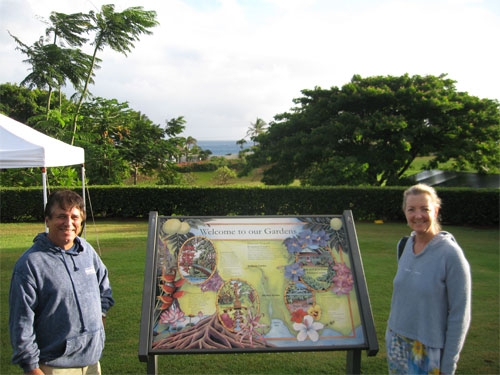Lesley and I recently returned from a relaxing vacation on Kauai. Granted, it’s not a large island, but by pure coincidence we often seemed to find ourselves situated in places that were especially suited to our interests. Along the south shore, just a mile down the street from our timeshare, happen to be what are arguably the most beautiful tropical botanical gardens in the world.
Of the five National Tropical Botanical Gardens (NTBG) of the United States, four are in Hawaii, and of those four, three are on the aptly named ‘garden isle’ of Kauai. All three are magnificent.
For an herbalist, hanging out at any one of these is akin to a being a Catholic bishop spending time at the Vatican in Rome. We are regular annual donors at the family level of $150. This entitles us to free tours and entrance to these gardens throughout the year. I think of it as the opportunity to enjoy them as my Hawaiian backyard without having to deal with the work of pulling weeds, watering and maintenance that every home garden requires.
The gardens nearest our timeshare are the famous Allerton and McBryde gardens, named after their founders. These gardens are strictly funded by private contributors. I strongly recommend checking them out and becoming a yearly member, especially if you regularly visit Kauai.
The Hawaiian Islands are the most remote land mass on earth with an important natural eco-system. Tragically, only 1% of all the plants found on Hawaii are native to the islands. This means that as breathtakingly beautiful as this vacation mecca is, most of the islands’ native plants have become extinct or are endangered by introduced species.
Botanic gardens like the Allerton and McBryde serve as safe havens for these imperiled plants. Sure, I’d like to see more herbalists included as part of the staff and advisory board for these organizations, but I recognize that at least for the present, these gardens are important living laboratories for scientists who strive to better understand the evolution, structure, relationships, and qualities of the species of plants within their boundaries. Further, they can be used as classrooms where students of all ages can learn about environmental stewardship.
A HUMAN LOVE AFFAIR WITH PLANTS
Certainly as herbalists and plant lovers, we have unique perspectives on the importance of plants. I would say that every plant has a use and medicinal property of some sort; in some cases it’s just a matter of discovering what these properties may be and then learning the appropriate applications and dosage. This is part of the meaning of Planetary Herbology — respecting and discerning the potential healing properties of what plants grow around you, wherever you may be.
As an herbalist, I believe that as far as plants go, you either “use it or lose it,” meaning that while using and over-harvesting plants may for the short term endanger them, over the long term, if they are useful and humans know their real value, people will learn to cultivate them to assure a continued supply. Thus, gardens like the ones I mention above play an important intermediate role in that process.
However, I think that any human infatuation with plants for their practical uses is equal to, if not eclipsed by, our aesthetic appreciation of them and the various natural places and gardens where they grow.
I might even conjecture that our forebears’ fascination with plants takes an equal place alongside their fascination with the heavens to form the very root of our sense of what is wondrous and beautiful. As important as our ability to create beautiful music, painting, sculpture, or poetry, is our ability to recognize beauty in nature and particularly in plants, which, with all their diversity of form and appearance, represent the purest expression of the creative impulse of nature.
So even if one may not think one has much personal creative talent, one participates in the arts just as well by nurturing one’s innate ability to recognize and appreciate beauty in all forms. This is an expression of the divine within us. Wherever you are, may you never be without the healing powers of plants — be they the powers of their medicine or the powers of their astounding loveliness.

